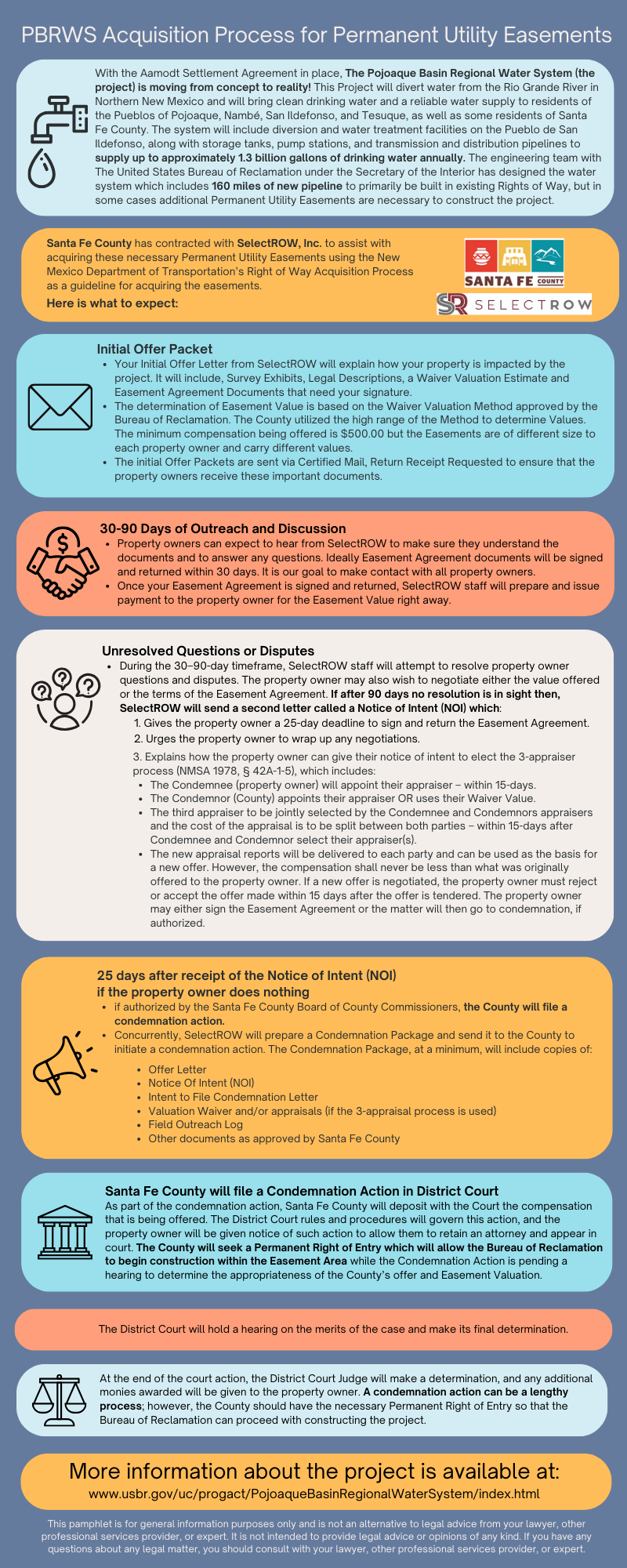Overview
Santa Fe County, the Pueblos of Nambe, Pojoaque, San Ildefonso and Tesuque, the State of New Mexico, the United States, and the City of Santa Fe (“Settling Parties”) entered into a Settlement Agreement, which was approved and adopted by the Federal Court in 2016. The final judgment and decree was filed on July 14, 2017. The Agreement primarily concerns the water rights of the four Pueblos in the Aamodt adjudication within the Nambé-Pojoaque-Tesuque basin, but it also makes certain beneficial concessions regarding non-Pueblo water rights. The goal of the Settlement Agreement is to resolve the Pueblos’ water rights claims while preserving existing non-Pueblo water uses. This goal is achieved, in part, by bringing more water into the Pojoaque Basin through the construction of a regional water system for both Pueblo and non-Pueblo water users.
Settlement Process
Congress enacted the Aamodt Litigation Settlement Act at the end of 2010. The Act provides federal funding for the water system. Since that time the Settlement Parties have worked to implement the Settlement Agreement. On April 10, 2012, the Santa Fe County Board of County Commissioners approved Resolution 2012-53 authorizing amendments to the Settlement Agreement. The Settlement Agreement and Cost-Sharing Agreement were publicly signed by the United States, the Pueblos, the State, the County, and the City in March 2013.
Between December 2013 and March 2016, the Court allowed a period for objections to the Settlement. It entered its decision on March 21, 2016, overruling all objections, approving the Settlement Agreement, and incorporating it into a partial final decree. Acceptance of the Settlement Agreement by the federal court avoids adjudicating the Pueblos’ water rights through protracted and expensive litigation, protects less senior water rights that comply with the Settlement, and enables the construction and access to a regional water system that will bring new water into the basin.
Options for Domestic Well Owners: the “Well Election”
The Settlement Agreement does not require domestic well owners to “give up” their wells or connect to the regional water system. However, it does require them to make a formal decision about their future well use, referred to as “well election,” if they desire to become a “Settlement Party” and to be protected from priority enforcement by the Pueblos. A well election is made by filing an Acceptance Form with the Court.
In making a well election, domestic well owners may select among the following options:
| 1. | To connect to the County Water Utility as soon as service is available in accordance with Sections 3.1.7.2.1 and 3.1.7.4.1 of the Settlement Agreement. The Nambé-Pojoaque-Tesuque Water Master Rule [19.20.25 NMAC] allows for well owners to transfer a portion of their permitted water use (0.3 acre-feet per year) to the County Water Utility or other system operator and use the remaining amount for outdoor use. |
| 2. | To keep their well but limit their amount of use in accordance with Section 3.1.7.2.2 and 3.1.7.4.2 of the Agreement. |
| 3. | To continue using their well but limit the amount of use until their property is transferred to a new owner (e.g., by sale or inheritance) in accordance with Section 3.1.7.2.3 and 3.1.7.4.3 of the Settlement Agreement. The new owner would be required to connect to the County Water Utility or other system operator. |
A detailed description of each of these options can be found in the section of the Settlement Agreement regarding domestic wells, Section 3.1.7: Final Aamodt Settlement Agreement with Signatures (PDF) April 2012. A chart that describes these options can be found on page 3.2 of the 2014 Aamodt Settlement Handouts. The Water Master Rulewas issued in September 2017.
Acceptance forms must be filed with the U.S. District Court. To do so, you must file the original and three copies (one of which will be your Court- stamped copy) of the Acceptance and Election at the Clerk’s Office at one of the United States Courthouses which are located at:
In person:
120 South Federal Place in Santa Fe
200 E. Griggs in Las Cruces
In person or by mail:
333 Lomas Blvd. NW, Suite 270 in Albuquerque
Those individuals who file by mail will recieve a Court stamped copy by including a preaddressed stamped envelope.
Pojoaque Basin Regional Water System
The Regional Water System is an important part of the Settlement Agreement. The system will divert water from the Rio Grande at Pueblo de San Ildefonso, treat it, transmit it to storage facilities through underground pipelines, and deliver it to Pueblo and non-Pueblo residents. The general requirements of the project are outlined in the HKM Engineering report, the Pojoaque Regional Water System Engineering Report. (Please note that because of the size of the report, it may take 1 to 2 minutes for your computer to open the link). The U.S. Bureau of Reclamation is tasked with further planning and building the project. The Bureau of Reclamation completed the final Pojoaque Basin Regional Water System Environmental Impact Statement on January 12, 2018. Specific aspects of the project are being developed throughout the planning process.
The system will be managed by the Pojoaque Basin Regional Water Authority (“the Authority”). Santa Fe County may serve as the initial “system operator” to provide water to customers within the Pojoaque Basin under a contract with the Authority. The system will be structured and operated to provide safe and reliable potable water to the residents of the Pojoaque Basin. The project will also provide water for fire suppression.
160 miles of new pipeline will be built primarly in exisiting Right of Way, but in some cases additional Permanent Utility Easements are necessary to construct the project. The County process of acquiring Permanent Utility Easements is described here:

Ongoing Adjudication
A water rights adjudication is a specialized court proceeding which is required by New Mexico law and is designed to determine and describe in a final decree all existing water rights in a stream system. The water rights in the Pojoaque Basin Stream System are being adjudicated in the case, State of New Mexico, ex rel. State Engineer v. Aamodt, et al. The case was filed in 1966, making it the oldest federal court case in the United States. The participants in the adjudication include all individual water users, local, state and federal governments, and the four Pueblos. The final judgment and decree was filed by the Court on July 14, 2017. The final decree incorporates the Pueblos’ partial final decree and other pertinent orders of the Court for the purpose of identifying, quantifying, and fully describing all water rights within the Pojoaque Basin Stream System.
For each water right established under New Mexico state law (as opposed to federal law), the decree describes the amount, purpose and place of use, source, and priority of the water right. In general, the amount of use of a water right is based on an owner’s historic beneficial use of water. The priority date of a water right under state law relates back to the first use of water, which in the case of acequia or ditch rights may have occurred several centuries ago.
When comparing two water rights, the one having the earlier priority date is called the “senior right,” and the one having the later date, the “junior right.” In times of water shortage, seniors have a right to a full supply and, if the exercise of a junior right interferes with the senior right, the senior may ask the Court or a water master to curtail the junior’s use, which is called a “priority call.” The actual curtailment is referred to as “priority administration” or “priority enforcement.” Because the date of their first use was before recorded history, the Pueblos have the most senior water rights in the Pojoaque Basin.
The Settlement Agreement identifies, describes, and limits the Pueblos’ water rights in the Basin. Importantly, it also limits the Pueblos’ right to seek curtailment of junior water uses of non-Pueblo well owners who become Settlement Parties. Documents filed with the Court in the Aamodt adjudication may be found at the Office of the State Engineer website: http://www.ose.state.nm.us/Legal/Adjudication/Aamodt/adj_aamodt.php
An overview of the Aamodt adjudication may be found at the Utton Center website: http://uttoncenter.unm.edu/projects/water-matters.php in Water Matters!, Chapter 22.
2014 Informational Handouts:
- Aamodt handout from meetings/workshops (Including FAQ's)»
- Comparative Costs of Water at Various Utilities around the Aamodt Settlement Area»
Documents filed in the case may be viewed at:
http://www.ose.state.nm.us/Legal/Adjudication/Aamodt/adj_Aamodt_court_filings.php
Other Important Documents and Forms
- Interim Administrative Order - March 23, 2016 (PDF)
- Summary Overview of the Settlement (PDF)
- Final Aamodt Settlement Agreement with Signatures (PDF) April 2013
- Aamodt Litigation Settlement Act
- Acceptance Form
- Cost-Sharing and System Integration Agreement
- Application to Transfer Water Rights from the Top of the World Farm to the Pojoaque Basin
- Santa Fe County Aamodt Related Resolutions
For more information about the adjudication, the case and the settlement:
Pojoaque Basin Regional Water System EIS - https://sites.google.com/site/pbwatereis/home
OSE: Access to water right records - http://nmwrrs.ose.state.nm.us/nmwrrs/disclaimer.html
OSE: Settlement information and proposed Agreement - http://www.ose.state.nm.us/Legal/settlements/Aamodt/index_aamodt.php
Utton Transboundary Resources Center - http://uttoncenter.unm.edu/ombudsman/npt.php
|
For more information about the Regional Water System and the |
